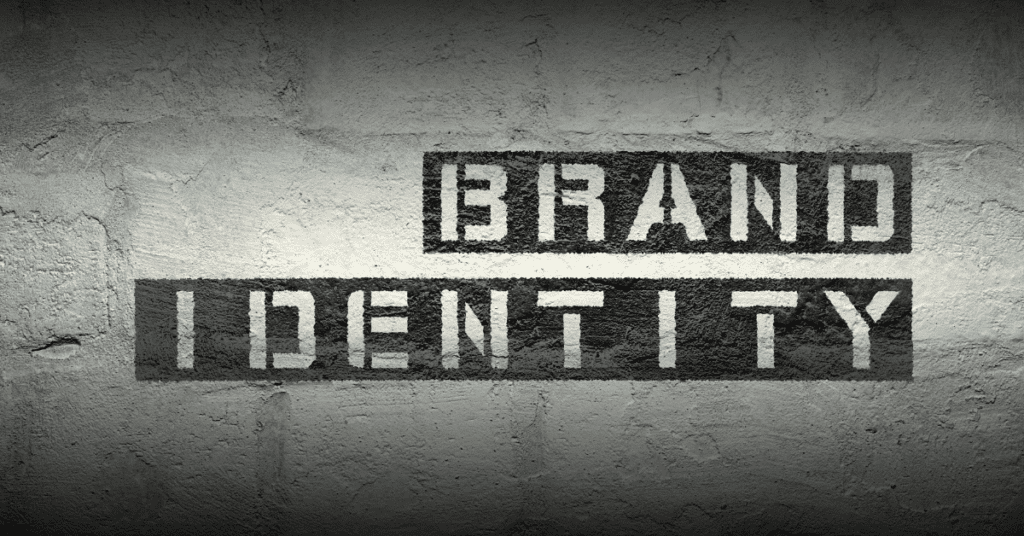Whether you’re a brand new entrepreneur or a tried and tested business owner, building a brand strategy is a key component to long-term success. A successful brand is established, easy to recognize, and fully representative of the business itself. It’s so much more than buying a basic logo on Fiverr.
So, first things first – exactly what is brand strategy?
A brand strategy is the process of creating a brand that will hold a unique place in the market. Not only should your brand strategy work to help you achieve your long-term goals, but a strong brand strategy will also result in recognition and easy identification. Simply put, a great brand, along with a marketing strategy, will lead your customers back to you over and over again because they know you – and they love you!

What isn’t a brand strategy?
Ok, that might not be the best grammar you’ve ever seen but let’s unpack what a brand strategy is NOT. It’s not a logo. It’s not even a logo and a color palette. And adding a website to the mix doesn’t change our answer either.
The brand strategy process begins BEFORE the design elements are created and blend them with intangible elements that help you show up to your customers and clients. The ultimate goal is to drive brand awareness and loyalty. To know you is to love you more and more when a brand strategy is in place.
Essential Elements of a Strong Brand Identity (that is a critical part of building a killer strategy)
ONE: Your Mission and Purpose
Believe it or not, knowing who you are is key to all branding strategies. It’s like the old dating adage – “if you don’t love yourself, how do you expect anyone else to?” A bit harsh but still very true. And in digital and traditional marketing, it translates into, if you don’t know who you are, how will anyone else?
A lot of different companies sell the same product. For example, I can buy a great candle on Amazon just as easily as I can buy one at TJ Maxx, Target, and even the local store down the street. The visual identity of the candle may be similar. In fact, it might be the same candle at all of these stores. But as a consumer, I never buy candles on Amazon.

Why?
Amazon is undoubtedly the most convenient. And it’s often the cheapest. But for me, buying candles is more than a quick – prime delivery – fix. I enjoy the emotional benefits of lighting a fantastic candle that reminds me of a season or an experience.
I don’t mind buying toilet paper on Amazon. But I almost always buy my candles from a local purveyor in person. Especially when that local store or hotel is one I love, frequent, and know. A well-executed brand strategy affects more than the color choice on your website, it tells the story of who you are and the value you bring.
A successful brand strategy for my local boutique tells me they serve my community, they create an engaging shopping experience, they value quality. Maybe they’re female-owned or operating as a cooperative. Whatever the story, it’s one that is recognizable and that I immediately understand – thanks to the positioning they’ve done as a function of a brand strategy.
Amazon’s brand positioning is quick, easy to use, value. There is nothing wrong with either, but one gets my business for luxury candles that invoke a positive emotional experience, and the other gets my order for paper goods.
Resources: How to Develop a Brand using Branding Strategy Template
TWO: Consistency, Consistency, Consistency.
Your brand messaging and branding strategy becomes clearer once you know your mission and purpose. That’s because with each social media post, website update, ad, blog, and more, you build brand recognition.
Brand recognition doesn’t happen the first time someone sees you online. It takes time and consistency to become recognizable through multiple interactions. And if you’re not clear on your mission, then even if you show up consistently, people won’t recognize you because it doesn’t always look and feel the same.
Let’s break this down. If, for example, you have a dog food store and your mission is to feed hungry dogs with love, you know that you’ll regularly be posting about loving dogs, dog foods on the market, and how they’ll support your dog’s health, maybe even specials on treats!
Because you’re super clear on your brand strategy, you’ll also know that posting about cats doesn’t really fit the mission. Collars don’t make the cut either. That’s the beauty of a comprehensive brand strategy – you get to the heart of who you are as a brand, which means you build consistency no matter what you’re doing.
Designing creative elements such as brand colors and logos, writing in a brand voice, posting on social media – it all attracts your target audience because you’ve done the work upfront to identify your core values and market position. And thanks to that work, you have the necessary elements to create a solid brand strategy that makes you instantly recognizable as you show up consistently.
THREE: Emotional Connection.
How do you develop emotional connection when you’re selling kibble? Remember, it’s not about the kibble. Right? It’s about the emotional connection current and potential customers feel with their dogs. A good brand strategist can help you unpack the emotional connection with your customer base by going back through your existing brand identity and core mission.
Maybe you’re thinking – “Well, sure. Anyone can see the emotional connection with their beloved pet. Why not pick something harder?” No problem. Let’s say we’re working with a brand that cleans rugs. There’s nothing inherently warm and fuzzy about rug cleaning. Other companies might focus on the consumer needs – removing stains, getting the cheapest deal.
And while all of those are practical ways to position a brand, how might your consumers feel if, instead of getting a good deal, you talked about the joy of spending time with family on your freshly cleaned rug? From knowing it’s safe for kids to cuddling up with your significant other, it’s not about fewer stains. It’s about more memories! Those elements build better brand equity than simply the facts, especially in competitive environments.
In other words, no matter what market share you’re looking to corner, the best way to do it is to make an emotional connection that serves more than a practical need. That is something the best brands make look easy.
FOUR: Recognition of Your Customers.
Great brands make it easy to love them, thanks to the recognition of new clients – and those that hang around. A new brand (or company rebranding) can do well to follow that example. Let’s talk about two companies that enter an industry simultaneously. We’ll even go so far as to say that they sell a relatively similar product or concept. Customers are interested in these companies and trial a product from both.
Company A developed strategies focusing on marketing their product, and they are excited when the orders come in. Company B was developing a brand strategy at the same time, but in addition to marketing and branding, they spent time developing a plan for recognizing a customer.
Company A and B create a great experience for the customer, but only Company B sends out a follow-up after the order. They thank the customer for their business with a personalized email – maybe even a coupon. Perhaps they recognize when this customer tells a friend about their product or service with a referral incentive. Over time, they stay connected with that customer and look for regular ways to engage as a part of their brand strategy.
A winning brand strategy continues the mission and values into every part of the experience customers have with their company. This is why it is so foundational to develop your entire brand identity before launching marketing efforts or advertising in a given industry.
So What Now?
If you have clarity around your mission and purpose, the importance of consistency, making an emotional connection, and recognizing your customers, it’s time to begin building your brand strategy. While many new entrepreneurs are anxious to start selling or marketing their new business, taking the time to fully create your business strategy can be the difference between a lasting brand and a brand that fails.

Exactly what is necessary to develop an effective brand strategy?
Many things go into a well-defined brand strategy, but we’re breaking down the basics of how to get started.
First things first, know your business.
Building a business is a long game, so don’t underestimate the power of a solid business plan. We’re not talking about outdated proposals you create to show a bank when asking for a loan. We’re talking about understanding your competitors and their competitive advantage, outlining how you’ll find customers (are you going in with a strong marketing budget, or is organic growth critical).
Next, know your consumers!
As fellow entrepreneurs, we know that frequently starting out means saying yes more often than no. You need customers, and you may take on too many without defining your target audience. That is a part of the journey. But that doesn’t mean you should skip the step of understanding who you’re ideal customers are – and learning how to attract them. A unique voice in the market does not say, “we serve everyone with everything,” so creating a plan that involves your ideal customer is helpful.
Once you’ve created brand strategies to attract your customers, guess what? You can learn and grow and make adjustments along the way. At The MMC Agency, our original customers came to us for copywriting. But over time, we begin to do more and more design work as a company. This led to a major shift a few years into the MMC story and helped us clarify the customers we served best. Adding a new audience to your business is a great example of growth and will likely happen. That being said, start with who you intend to serve today and get to know them as a company.
It’s time to unpack your positioning.
Now that you know who you’re planning to attract, you can dive deeper into why they’d want to work with you. A brand strategy helps to uncover how you’ll stand out in the market. Are you a fresh voice? Do you have a brand new product? Are you reaching an underserved audience?
Positioning your brand comes down to understanding your unique place in the market and including a statement that explains why your potential customers should choose you over your competitors!
Now you’re ready to develop your visual brand!
By now, most of the clients we work with have chosen a name for their company. And once we understand who they are and who they serve, we recommend getting to work on the logo that will represent the brand.
At The MMC Agency, our branding experience includes diving deep into inspiration and mission to create a complete company logo suite, color scheme, font selections, and more. It’s the total package to display your brand to consumers visually, and it’s essential to distinguish you from competitors.
In our personal experience, the next logical step for many companies is to take the visual brand and create a website! We use the branding we’ve created to flow into the website, along with a strategy that makes a seamless user experience.
Track and Adjust.
What many competitors get wrong with a branding strategy is the idea that you can set it and forget it. In fact, building a successful brand means checking in on progress and making adjustments as needed.
We mentioned above that as companies grow, they will learn more about who they serve best and identify changes that will help them be successful. We’ve all seen brands that didn’t check in or stay directly connected with their audience or market, and as a result, they’re long gone. New brands replaced them! We recommend reviewing your brand strategy and making changes as you – and your consumers – grow.
Need Help with Your Branding Strategy?
If you’re thinking about hiring a team of copywriters and web designers for your brand, we can help. Our team has the expertise to help you go from outlining your mission to taking your brand online.
